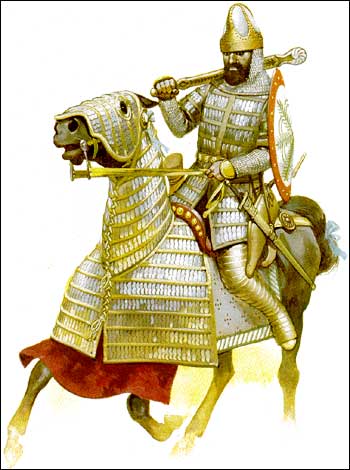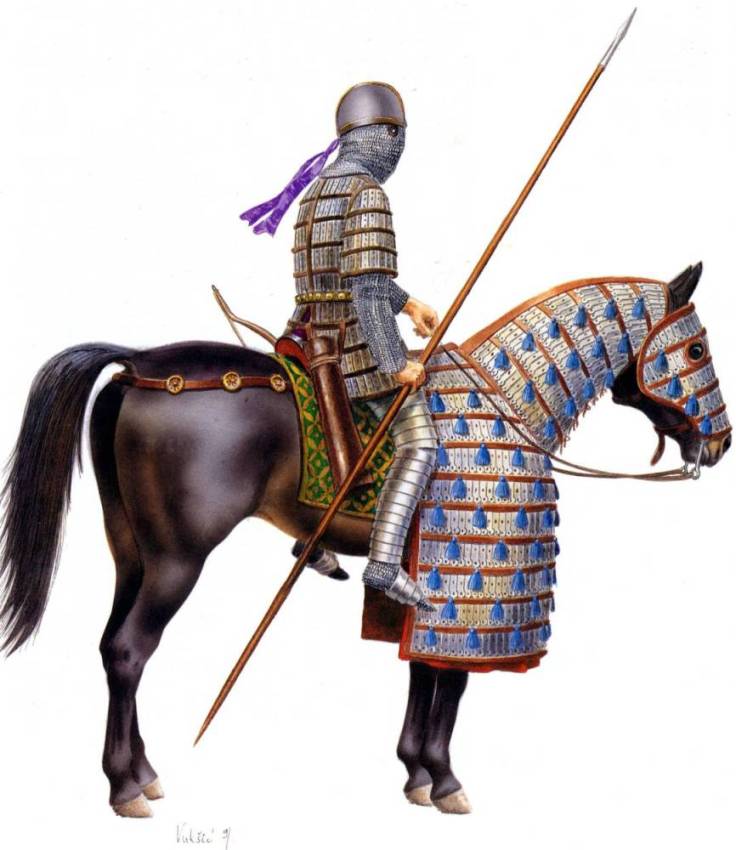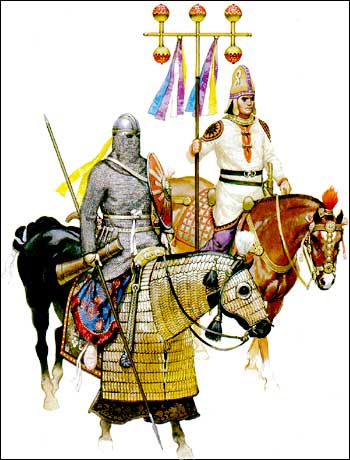The described horsemen are represented by the seventh-century knight depicting Emperor Khosrow Parvēz
on his steed Šabdiz on a rock relief at Tāq-e Bostān in
Kermānšāh [162].
Since the Sasanian horseman lacked the stirrup,[163]
he used a war saddle which, like the medieval type, had a cantle at the back and two guard clamps curving across the top of the rider's thighs
enabling him thereby to stay in the saddle especially during violent contact in battle.[164]
The inventory of weapons ascribed to Sasanian horsemen at the time of Khosrow Anōšīravān,[165]
resembles the twelve items of war mentioned in Vendidad 14.9,[166]
thus showing that this part of the text had been revised in the later Sasanian period. More interestingly,
the most important Byzantine treatise on the art of war, the Strategicon, also written at this period,
requires the same equipments from a heavily-armed horseman.[167]
This was due to the gradual orientalisation of the Roman army to the extent that in the sixth century
"the military usages of the Romans and the Persians become more and more assimilated,
so that the armies of Justinian and Khosrow are already very much like each other;" and, indeed,
the military literatures of the two sides show strong affinities and interrelations.[168]
According to the Iranian sources mentioned above, the martial equipments of a heavily-armed Sasanian horseman were as follows: helmet,
hauberk (Pahlavi grīwbān), breastplate, mail, gauntlet (Pahlavi abdast),
girdle, thigh-guards (Pahlavi rān-bān), lance, sword, battle-axe, mace, bowcase with two bows and two bowstrings, quiver with 30 arrows,
two extra bowstrings, spear, and horse armour (zēn-abzār);
to these some have added a lasso (kamand), or a sling with slingstones.[169]
The elite corps of the cavalry was called "the Immortals,"
evidently numbering-like their Achaemenid namesakes 10,000 men.[170]
On one occasion (under emperor Bahram V) the force attacked a Roman army
but outnumbered, it stood firm and was cut down to a man.[171]
Another elite cavalry group was the Armenian one, whom the Persians
accorded particular honour.[172]
In due course the importance of the heavy cavalry increased and the distinguished horseman assumed the meaning of "knight" as in European chivalry;
if not of royal blood, he ranked next to the members of the ruling families and was among the king's boon companions.[173]
The Sasanians did not form light-armed cavalry but extensively employed-as allies or mercenaries-troops from warlike tribes who fought under their own chiefs.
"The Sagestani were the bravest of all";[174]
the Gelani, Albani and the Hephthalites, the Kushans and the Khazars were the main suppliers of light-armed cavalry.
The skill of the Dailamites in the use of sword and dagger made them valuable troopers in close combat,[175]
while Arabs were efficient in desert warfare.[176]
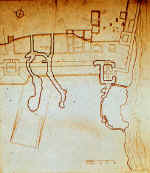
Plan of tunnels under the Dura-Europos by the Sasanians prior to the siege of the city in 300 CE.
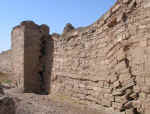
Collapsed wall under Tower 19
|
The infantry (paygān) consisted of the archers and ordinary footmen.
The former were protected "by an oblong curved shield, covered
with wickerwork and rawhide". [177]
Advancing in close order, they showered the enemy with storms of arrows.
The ordinary footmen were recruited from peasants and received no pay,[178]
serving mainly as pages to the mounted warriors; they also attacked walls,
excavated mines and looked after the baggage train, their weapons being a
spear and a shield.[179] The cavalry was better
supported by war elephants "looking like walking towers",[180] which could cause
disorder and damage in enemy ranks in open and level fields. War chariots
were not used by the Sasanians.[181]
Unlike the Parthians, however, the Iranians organised an efficient siege
machine for reducing enemy forts and walled towns. They learned this
system of defence from the Romans but soon came to match them not only in
the use of offensive siege engines-such as scorpions, balistae, battering
rams, and moving towers-but also in the methods of defending their own
fortifications against such devices by catapults, by throwing stones or
pouring boiling liquid on the attackers or hurling fire brands and blazing
missiles.[182]
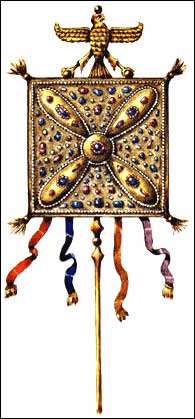
Drafš-a Kāviān
|
The organisation of the Sasanian army is not quite clear, and it is not even
certain that a decimal scale prevailed, although such titles as hazārmard[183]
might indicate such a system. Yet the proverbial strength of an army was
12,000 men.[184]
The total strength of the registered warriors in 578 was 70,000.[185]
The army was divided, as in the Parthian times, into several gunds,
each consisting of a number of drafšs (units with particular banners), each made up of some Wašts.[186]
The imperial banner was the Drafš-a Kāviān, a talismanic emblem accompanying the King of
Kings or the commander-in-chief of the army who was stationed in the
centre of his forces and managed the affairs of the combat from the
elevation of a throne.[187]
At least from the time of Khosrow Anošīravān
a seven-grade hierarchical system seems to have been favoured in the
organisation of the army.[188]
The highest military title was arghed [189] which was a prerogative
of the Sasanian family.[190]
Until Khosrow Andōšīravān's
military reforms, the whole of the Iranian army was under a supreme
commander, Erān-spāhbed, who acted as the minister of defence,
empowered to conduct peace negotiations; he usually came from one of the
great noble families and was counted as a counselor of the Great King.[191]
Along with the revival of "heroic" names in the middle of the
Sasanian period, an anachronistic title, artēštārān
sālār[192]
was coined to designate a generalissimo with extraordinary authority, but
this was soon abandoned when Anōšīravān
abolished the office of Erān-spāhbed and replaced it with those
of the four marshals (spāhhed) of the empire, each of whom was the
military authority in one quarter of the realm.[193]
Other senior officials connected with the army were: Erān-ambāragbed
"minister of the magazines of empire," responsible for the arms
and armaments of warriors;[194]
the marzbāns "margraves"-rulers of important border
provinces [195];
kanārang-evidently a hereditary title of the ruler of Tūs;[196]
gund-sālār "general" [197];
paygān-sālār "commander of the infantry";[198]
and puštigbān-sālār
"commander of the royal guard".[199]
A good deal of what is known of the Sasanian army dates from the sixth and
seventh centuries when, as the results of Anōšīravān's
reforms, four main corps were established; soldiers were enrolled as state
officials receiving pay and subsidies as well as arms and horses; and many
vulnerable border areas were garrisoned by resettled warlike tribes.[200]
The sources are particularly rich in accounts of the Sasanian art of
warfare because there existed a substantial military literature, traces of
which are found in the Šāh-nāma, Dēnkard
8.26-an abstract of a chapter of the Sasanian Avesta entitled Artēštārestān
"warrior code"-and in the extracts from the Ā'in-nāma
which Ebn Qotayba has preserved in his `Oyūn al-akhbār and
Inostrantsev has explained in detail.[201] The Artēštārestān
was a complete manual for the military: it described in detail the
regulations on recruitments, arms and armour, horses and their equipments,
trainings, ranks, and pay of the soldiers and provisions for them,
gathering military intelligence and taking precaution against surprise
attack, qualifications of commanders and their duties in arraying the
lines, preserving the lives of their men, safeguarding Iran, rewarding the
brave and treating the vanquished.[202]
The Ā'in-nāma furnished valuable instructions on tactics,
strategy and logistics. It enjoined, for instance, that the cavalry should
be placed in front, left-handed archers capable of shooting to both sides
be positioned on the left wing, which was to remain defensive and be used
as support in case of enemy advance, the centre be stationed in an
elevated place so that its two main parts (i. e., the chief line of
cavalry, and the lesser line of infantry behind them) could resist enemy
charges more efficiently, and that the men should be so lined up as to
have the sun and wind to their back.[203]
|
Battles were usually decided by the shock cavalry of the front line charging the
opposite ranks with heavy lances while archers gave support by discharging
storms of arrows. The centre, where the commander-in-chief took his
position on a throne under the Drafš-a Kāviān, was defended by the strongest units. Since the carrying of
the shield on the left made a soldier inefficient in using his weapons
leftwards, the right was considered the line of attack, each side trying
to outflank the enemy from that direction, i.e., at the respective
opponent's left; hence, the left wing was made stronger but assigned a
defensive role [204].
The chief weakness of the Iranian army was its lack of endurance in close
combat.[205] Another fault was the
Iranian's too great a reliance on the presence of their leader: the moment
the commander fell or fled his men gave way regardless of the course of
action.
During the Sasanian period the ancient tradition of single combat (maid-o-maid)
developed to a firm code.[206]
In 421 Emperor Bahram V opposed a Roman army but accepted the war as lost
when his champion in a single contest was slain by a Goth from the Roman
side.[207]
Such duels are represented on several Sasanian rock-reliefs at Naqs-a
Rostam,[208]
and on a famous cameo in Paris depicting Emperor Shapur I capturing
Valerian.[209]
Sasanian Emperors were conscious of their role as military leaders: many took part
in battle, and some were killed; the Picture Book of Sasanian Kings showed
them as warriors with lance or sword.[210]
Some are credited with writing manuals on archery,[211]
and they are known to have kept accounts of their campaigns ("When
Kosrow Parvēz concluded his wars with Bahram-e L`ubina and consolidated his rule over
the empire, he ordered his secretary to write down an account of those
wars and related events in full, from the beginning to the end").[212]
While heavy cavalry proved efficient against Roman armies, it was too slow and
regimentalised to act with full force against agile and unpredictable
light-armed cavalry and rapid foot archers; the Persians who in the early
seventh century conquered Egypt and Asia Minor lost decisive battles a
generation later when nimble, lightly armed Arabs accustomed to skirmishes
and desert warfare attacked them. Hired light-armed Arab or East Iranian
mercenaries could have served them much better.
|
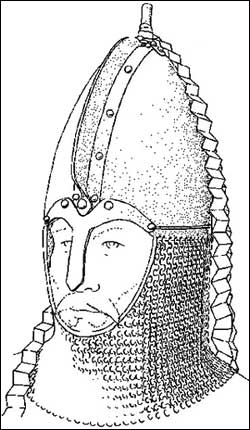
A Sasanian helmet from the siege mines beneath Tower 19,
Dura-Europos, today in Syria. It is a rare find of Sasanian military archaeology, and also clearly a prototype for Roman helmets of the 4th century CE.
|
[150]
Christensen, Smeden Kavah og det Gamle Persiske
Rigsbanner, Copenhagen, 1919, Iran Sass., p. 98
[151]
ibid., pp. 166f.
[152]
Dio Cassius 80.4.2; Herodian 6.2.2
[153]
Agathangelos [Greek version] 1.8
[154]
Tabari tr. Noldeke, Geschichte der Perser, p.5
[155]
Christensen, op. sit., p. 207
[156]
Ammianus Marcellinus 23.6.83
[157]
ibid.
[158]
Rundgren, Orientalia Suecana 6, 1957, pp. 35ff.
[159]
e.g. Ammianus Marcellinus 16.10.8
[160]
Rundgren, op. sit., pp. 48f., evidently unaware that the Pahlavi grīwbān
"neck-guard" is attested in Vendidad 14.9: AN. W. Jackson,
"Herodotus VII. 61, or the Arms of the Ancient Persians Illustrated
from Iranian Sources," in Classical Studies in Honour of Henri, Drisler,
New York, 1894, pp. 95ff. esp. p. 118
[161]
Ammianus Marcellinus 25.1.12-13, cf. 24.6.8
[162]
E. Herzfeld, AM191 1938, pp. 91 ff.
[163]
A. D. H. Bivar, "The Stirrup and its origins," Oriental Art, N.S.
1, 1965, pp.61-65
[164]
E. F. Schmidt, Persepolis III, Chicago, 1970, p. 135
[165]
Tabarī, I, p. 964 [tr. Noldeke, pp. 248f.]; Bal'ami, TarIkh, p. 1048;
Ferdowsī Šāhnāma VIII, p.63
[166]
Jackson, loc. cit.
[167]
Bivar in Dumbarton Oaks Papers 26, 1972, pp. 287-88
[168]
C. A. Inostrantsev, "Sasanian Military Theory," tr. L. Bogdanov in
Journal of the Cama Oriental Institute 7, 1926, pp. 7ff. esp. p.23
[169]
Noldeke, Geschichte der Perser, pp. 248f.; Jackson, op. cit., pp. 108ff.
[170]
Christensen, Iran Sass., p.208 with references
[171]
Socrates Scholasticus 7.20
[172]
Christensen, op. cit., p. 210
[173]
ibid., pp. 112, 368-69; J. M. Unvala, The Pahlavi Text "King qusrav and
his Boy," Paris, 1921
[174]
Ammianus Marcellinus 19.2.3
[175]
Agathias 3.17
[176]
Christensen, op. cit., pp. 209, 275
[177]
Ammianus Marcellinus 24.6.8
[178]
ibid., 23.6.83
[179]
ibid., 23.6.83; Procopius 1.14.24, 52; Christensen, op. cit., p.209
[180]
Ammianus Marcellinus 25.1.14; see also E. Herzfeld AMI 3, 1931, pp.26ff.
[181]
contra Alexander Severus in Lampridius, Vita Alex. Sev. 56
[182]
Ammianus Marcellinus 19.5f., 20.6-7, I1
[183]
Noldeke, Geschichte der Perser, p. 284 n. 2
[184]
Ferdowsī, Šāhnāma VIII, p. 343
[185]
Tabari, tr. Noldeke, p. 271
[186]
Christensen, op. cit., p. 210
[187]
A. Christensen, Smeden Kāv√§h, tr. Unvala,
pp. 28f.
[188]
M. Grignaschi, "Quelques specimens de la litterature sassanide
conserves dans les bibliotheques d'Istanbul," JA, 1966, pp. I
ff. esp. pp. 24, 42 n. 76
[189]
q.v.
[190]
Noldeke, op. cit., p. 5 n. 3
[191]
Christensen, Iran Sass., pp. 130f.
[192]
q.v., Greek rendering adrastadaran salanes: Procopius 1.6.18
[193]
Christensen, op. cit., pp. 131, 370
[194]
ibid., pp. 107-108
[195]
ibid., pp. 102, 108, 371ff.; 518ff.
[196]
ibid., pp. 108, 351, 507
[197]
ibid., p.210
[198]
ibid.
[199]
ibid.
[200]
ibid., pp. 367ff.
[201]
Journal of the Cama Oriental Institute 7, 1926, pp. 7-52; see also
Christensen, op. cit., pp. 215f.
[202]
Sanjana's tr. in Dēnkard,
vol. XVI, Bombay,1917, pp. 6ff.
[203]
Inostrantsev, op. cit., pp. 13ff.
[204]
ibid., pp. 16ff.; Bivar, op. cit., pp. 289f.
[205]
Ammianus Marcellinus 25.1.18
[206]
Christensen, op. cit., p. 216
[207]
Johannes Malalas [in B. G. Niebuhr, ed., Hist. Byzant. Scriptores, Bonn,
18311, p. 14a
[208]
Schmidt, Persepolis III, pp. 130ff.
[209]
R. Ghirshman, Iran 249 B.C.-A.D. 651: The Parthian and Sassanian Dynasties,
London, 1962, fig. 195
[210]
Hamza, pp.50-54; Mojmal, pp. 33ff.
[211]
Bivar, op. cit., p. 284
[212]
e. g., Shapur's inscription on the Ka'ba-ye Zardošt,
and cf. Ebrahim b. Mohammad Bayhaqi, al-Mohasen wa'lmosawi, ed. F. Schwally, Giessen, 1902, p. 481
|
(Iranian Army reconstructions, 1971)
|
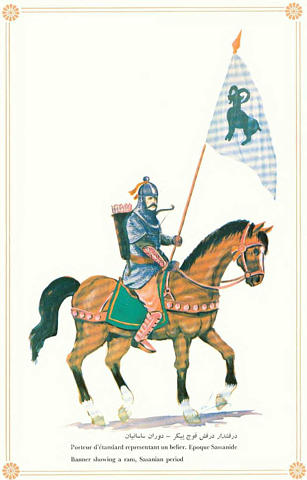
|
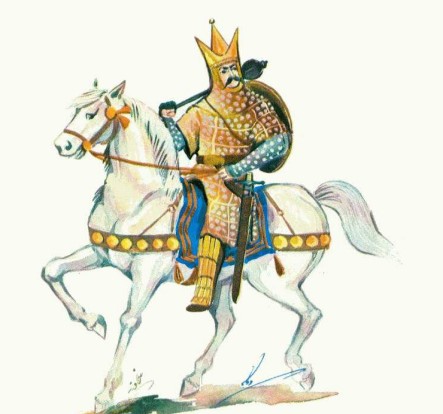
|
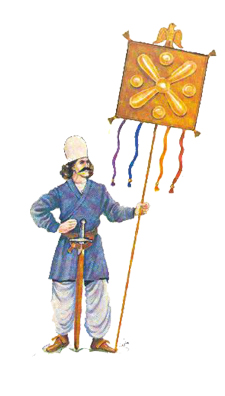
Sasanian Standard Bearer
with Kaviani Banner
|
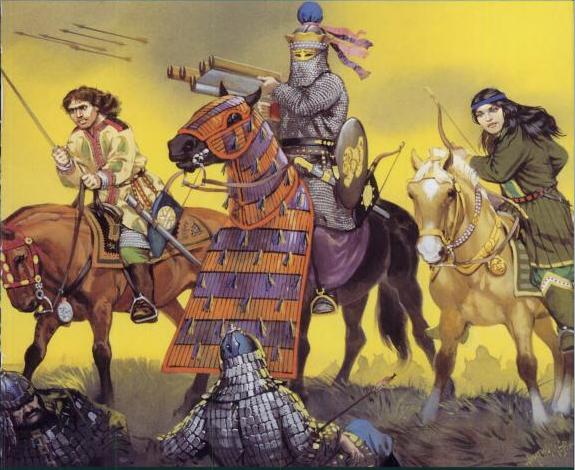
|
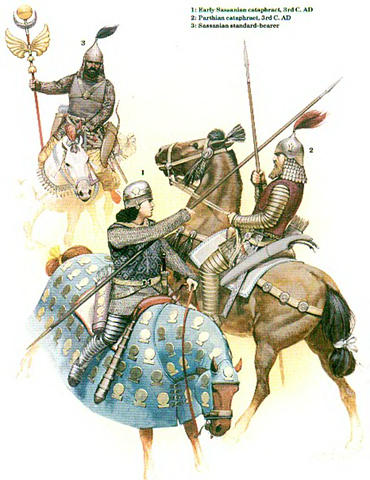
1: Early Sasanian cataphract
2: Parthian cataphract, 3rd C.Ad
3: Sasanian standard-bearer
|

